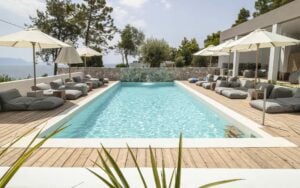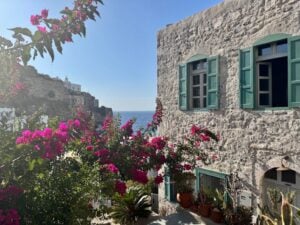Why is Plakias one of the most underrated towns on the island of Crete? Why choose Plakias over the larger towns like Rethymno and Chania in the north? We’re biased, of course, because the Elxis offices are in Plakias. But we’re willing to back it up!
About Plakias
This small harbor town lies in a big crescent bay holding a gorgeous beach between the gorges of Selia and Kourtaliotiko. It’s located on the south coast of Crete, about 30 kilometres south of the city of Rethymnon, and surrounded by mountains to the north and the Libyan Sea to the south. The name in Greek means “flat”, but the approach and coastline are quite mountainous and dramatic.

When to Visit Plakias
There is no bad time to visit Plakias. The high season starts in May and ends in October, but Plakias is also nice in winter and spring because of the smaller crowds.
Beaches in Plakias
Plakias has a 1300-metre-long sandy beach, there are a number of other beautiful beaches within walking distance (Souda, Damnoni, Ammoudi, and Shinaria) and there are plenty of places to eat along the sea front.
The Plakias beach itself has services like umbrellas, sunbeds, showers, and changing rooms. The water is incredibly clean and ideal for swimming. The water towards the west is slightly colder because it’s connected to the river Kotsifos.

Services in Plakias
Beside the school, town hall and its churches, there are also a selection of supermarkets, shops for holiday gifts, organic food stores, galleries, and clothing vendors. There are two pharmacies and a doctor’s office.
Plakias also has a post office, tour agencies, and car rental services.
Annual Events in Plakias
“World International Tourism Day” is celebrated each September with a big evening festival, with free street food and traditional music, songs, and dancing performances in the main square of Plakias.
Food and Drink in Plakias
The taverns in the mountain villages of Mirthios and Sellia, which are located just above Plakias, are incredible. The Elxis team has visited these tavernas personally, and we can confirm they are very tasty! The mountain village of Mariou also has great tavern. In Plakias, you will also find green grocers, bakeries, and butchers.

Weather in Plakias
Crete has hot summers and mild winters, with the longest summer season in Greece. The hottest month is July, when the temperate is 32 C in the day and 22 C at night. July is also the driest month, with 31 sunny days on average. The coldest month is January, with a high of 14 C and a low of 7 C.
Meltemi Winds
In the evening on the South of Crete, a cool breeze called the “Meltemi” provides a pleasant atmosphere. “Meltemi” is the name of the winds that typically appear in the Aegean Sea. They are dry and seasonal, and if you have ever been to the Cyclades (think Santorini, Mykonos, Paros, or Tinos), you’ve likely experienced this breeze – however, they appear as far south as Crete as well.

Day Trips from Plakias
Preveli
At 8 kilometres to the east you will find the historic monastery of Preveli, which may have been founded as early as the 10th century.
In the summer, swimmers often walk up along the river, under the shade of the palm trees, ascending toward the beautiful canyon. The little ponds that are formed along the way are great for wading in cool waters. There is also a ferry service here that can take you to Plakias.
The remote and peaceful Agia Fotini, Ligres, Triopetra, and Agios Pavlos are very tranquil and photogenic. Furthermore, hiking and diving are very popular activities in this region.

Asomatos
Just up the nearby mountain at an altitude of 230 meters is the traditional village of Asomatos, where you can have the best of everything. In a relaxed environment, sea views are very impressive from this village.
Records of Asomatos date back some 450 years when Crete was under Venetian rule and exposed to the Renaissance influence between 1204 to 1669.
Contact with nature here is unique. Hiking and biking are on offer while the Plakias beach is located just 4 kilometers away. To the north is the Asomatos gorge, which stretches up to 3 kilometers with lush vegetation. Along its length, huge cliffs of limestone, reaching 500 meters in height, are full of caves, home to many species of birds.




































